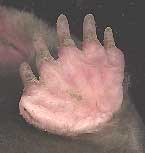 If you try for a perfectly manicured grassy lawn, you may have an awful opinion of moles such as the Eastern Mole, Scalopus aquaticus, shown at the right. People accuse moles of eating expensive flower bulbs, and no one doubts that moles make ridges in lawns and leave piles of naked dirt here and there.
If you try for a perfectly manicured grassy lawn, you may have an awful opinion of moles such as the Eastern Mole, Scalopus aquaticus, shown at the right. People accuse moles of eating expensive flower bulbs, and no one doubts that moles make ridges in lawns and leave piles of naked dirt here and there.
However, moles deserve better press, if only because they're so exquisitely adapted for their subterranean life, and because, ecologically, they do a good job loosening up and aerating the soil. Also, experts insist that moles don't eat flower bulbs. If bulbs have disappeared where a mole tunnel goes, it's because sometimes bulb-eating, mouse-like voles use mole tunnels...
Six mole species occur in the U.S., and just about everywhere except in the mountains and plateau area of the western states one or more species is present. Most locations, however, are home to only one or two species. As moles tunnel through the soil they mainly eat worms and insects, not tulip bulbs. As moles tunnel, they push the ground above them into ridges clearly visible in a mowed lawn. Tunnels are dug at two distinct levels. Only the upper level, immediately below the sod, shows up as ridges. The lower level, lying as deep as two feet, goes unnoticed. All the tunnels are connected into a complex network.
If you're ever lucky enough to catch a ridge being pushed up as the mole works below, draw near stepping as lightly as possible, and watch. You just may get to see earthworms shooting from the ground like toothpaste squirting from a tube being run over by a steam roller! The worms feel vibrations from the mole's digging, and something tells them they'd better leave the area fast. When you consider that earthworms have no legs or internal springs, their speed is really remarkable!
If you find a ridge in the process of being pushed up and you want to move the mole elsewhere, perhaps to save it from your neighbor's mole traps, here's one way to do it. Very softly come up behind the mole, then, as you see that the mole continues to work, quickly push a shovel blade into the ground a few inches behind where you think the mole's tail is. This blocks the tunnel behind him, cutting off his escape. Now place a wide-mouth jar on the ground just before the mole's head, and ease the shovel's handle down. As the handle lowers, the blade should angle upward, bringing the mole to ground level. If you've calculated everything right, he should pop up right so you can scoop the jar over him, look at him for a while, and then carry him someplace where ecosystem spirits will appreciate him.

Before letting him go, take time to marvel at his adaptations. Most transfixing are his front paws -- large, powerful things with claws perfectly designed for digging. That's one shown at the left. After the mole's paws, the most interesting adaptations are those you don't see. For example, underground animals wouldn't want dirt clogging their ears, so mole ears, while present, aren't to be seen. And in the tunnels' perpetual darkness, of what use are eyes? Moles do have eyes, but they're tiny slits covered with thin skin. Moles also have nostrils, but they open sideways, not forward, so dirt doesn't plug them as the mole tunnels forward.